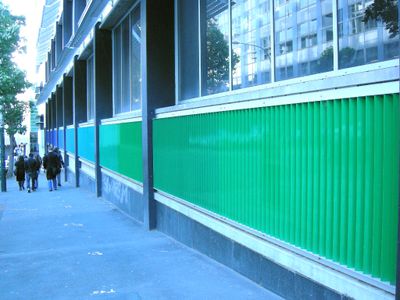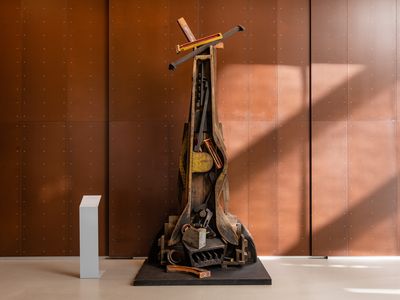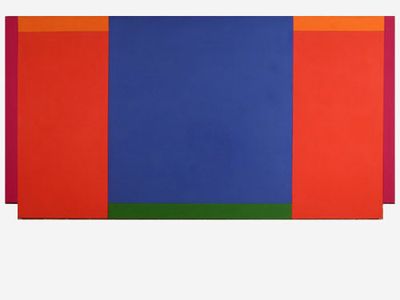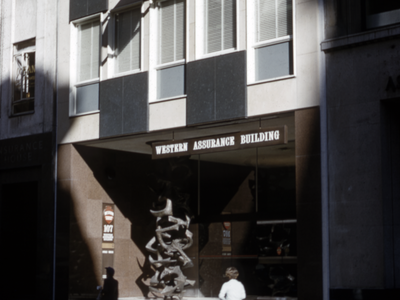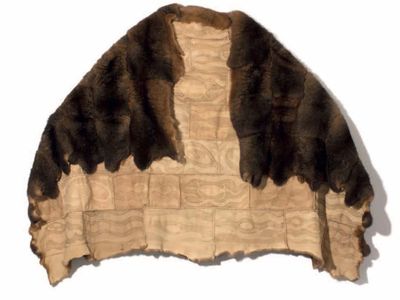Richard Larter
Big Bang
1992
acrylic on canvas
10 panels, 320 x 210 cm each, 320 x 2100 cm overall
Located in the UTS Tower
Building 1, Level 6
(CB01.06)
Larter’s multi-paneled Big Bang, 1992, is a no-holds-barred, crowd-pulling, roof-raising, Olympic-scaled showstopper. I would also argue that it is also a… Destination Masterpiece, of the kind that the National Gallery of Australia yearned to secure when it bought David Hockney’s A Bigger Grand Canyon, 1998, and Lucia Giordiano’s The Rape of the Sabines, 1672-74…
Bruce James, ‘Out of this World’, The Sydney Morning Herald, September 23, 2000.
At 21 metres long, Big Bang is one of the largest paintings ever made by the artist. The subject matter – the Big Bang theory of an ever-expanding universe – is writ large across the 10 panels and was painted following the artist’s readings of geometric or Ptolemaic astronomy. Big Bang was influenced by developments in mathematics and physics, by the landscape near Larter’s home in Yass, New South Wales, and by artists such as Henri Matisse, Georges Seurat and Robert and Sonia Delaunay, whose work he encountered during his formative years in London.
Larter took an experimental approach to painting, using rollers to create energetic lines of colour across the canvas. He often listened to music while he painted, which is reflected in the dynamic works he produced. This monumental painting was on loan to UTS from 2000 until 2008 when it was donated to the UTS Art Collection by Sydney gallerist Frank Watters, a close friend of the artist, to whom the painting is dedicated. Over his distinguished career, Larter was represented by the Watters Gallery and held over 50 solo exhibitions. His work is represented in the collections of the National Gallery of Australia, the Art Gallery of South Australia, Adelaide, the National Gallery of Victoria, Melbourne and National Portrait Gallery, Canberra.
Richard Larter (1929–2014) was born in Hornchurch, Essex, and studied art at St Martin’s School of Art, London and Toynbee Hall in London before completing his training as a teacher in Surrey in the mid 1950s. In 1962 his work was exhibited in the Paris Salon and that same year he immigrated to Australia with his family. Larter continued teaching in Sydney until 1972, then worked as an artist full-time. With his wife, Patricia Larter (1936-1996) he experimented with sound, film and performance as well as printmaking and painting. In 1996, their collaborative works were awarded the Peter Clemenger Prize for Contemporary Art and were included in the Adelaide Biennale and Melbourne Super Eight Festival.
Over his distinguished career, Larter was represented by the Watters Gallery in Sydney and held over 50 solo exhibitions. His work is represented in the collections of the National Gallery of Australia, the Art Gallery of South Australia, Adelaide, the National Gallery of Victoria, Melbourne and National Portrait Gallery, Canberra.
In 1999 the Watters and Legge galleries combined to celebrate Richard Larter’s oeuvre with a 70th birthday exhibition. This was followed by survey exhibitions at the Museum of Modern Art at Heide (2002), the Casula Powerhouse Arts Centre (2006), and a major retrospective at the National Gallery of Australia in 2008.



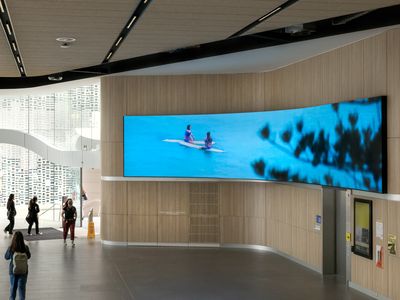
/https://uts-art-prod.s3.amazonaws.com/media/dd/images/02e4cd61f03a160c71ac5afa967a498c.jpg)
/https://uts-art-prod.s3.amazonaws.com/media/dd/images/3b7814e97b4b5428c7efccb0692cb077.jpg)

/https://uts-art-prod.s3.amazonaws.com/media/dd/images/e13b96183e5209d5a0c51399ffeaa31d.jpg)
/https://uts-art-prod.s3.amazonaws.com/media/dd/images/35b09f6824a0f758a2c126325ff22e5f.jpg)
